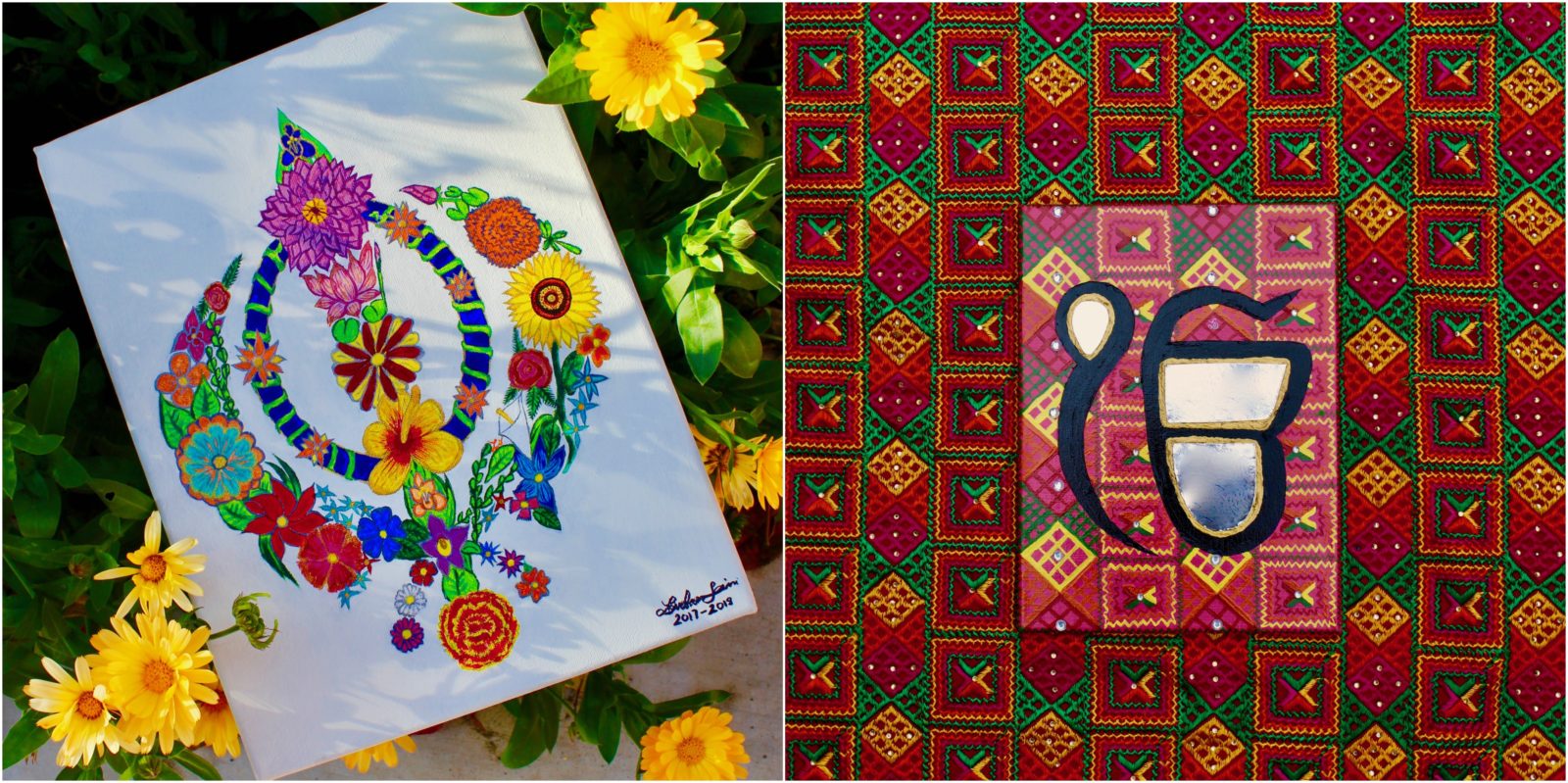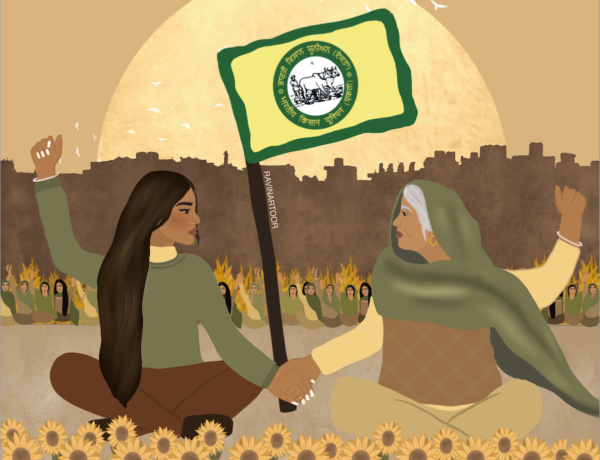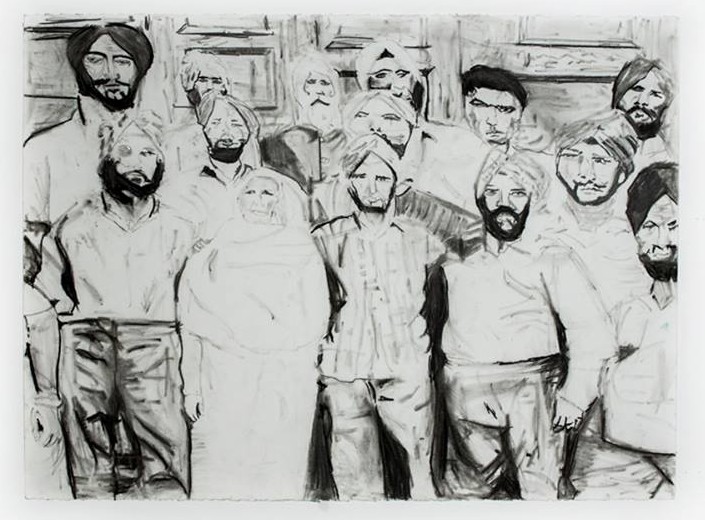Born and raised in Bay Area, California, aspiring Sikh artist, Loveleen Kaur Saini, shares her art and her creative journey with Kaur Life.
Tell us about these pieces:
My most prized piece is this floral Khanda. The idea manifested from how akhand paths have 2 vases full of fresh flowers on each side of Guru Granth Sahib. I also wanted to create this floral Khanda because Sikhi is mistakenly stereotyped to be hostile, when it’s quite gentle and beautiful in reality. I illustrated a variety of symbols in it, such as the gladiolus (the state flower of Punjab) and the lotus (national flower of India). I tried to use blue and orange (colors associated with Sikhi) enough for it to stand out the most in the middle chakkar. I spent about 3 weeks meticulously painting this Khanda.
The phulkari Ek Onkar was my way of weaving together the beauty of Punjabi culture and the impact that the concept of Ek Onkar has on me. I hope I did justice to it.
What materials did you use in this art?
I used only acrylic paints for the floral Khanda, after I finished sketching. The Ek Onkar art though, that was more complicated. I wanted to do justice to the beauty that is phulkari and simply paint on canvas could never be enough. So, I did my research and made a trip to my local art store to get self adhesive jewels and silver mirror paper. The signature of phulkari is how bright the colors are and the gorgeous sparkle. I couldn’t possibly leave it incomplete.
What do you hope your audience gets out of viewing this art?
I hope people can see how stunning our culture is alongside how gentle and welcoming our religion is. I want people to be intrigued, to gain curiosity about my rich roots because they ignite a passion in me and I hope to do the same for others.
What is your personal understanding of Ek Onkar?
I came to understand “Ek Onkar,” as the pillar in Sikhi representing “One Divine,” around adolescence when my family was struggling financially and my mother taught me how to properly pray. My parents were fraught with making ends meet but prayers brought a moments peace to our household. The moment, “Ek Onkar, satnam…” flowed from our lips, we all found sukoon, or peace in our souls. I’ll never forget that, just like I never forgot those prayers.
There’s a serenity within religion which gives me hope that it will be okay.
How and when did you get interested in art?
Only in the past year or so; I started sketching more often and slowly that progressed to keeping a sketchbook for all my ideas. I tried digitally painting but it didn’t seem like enough to me. I invested in a few art supplies and I knew that hands-on painting is what I prefer. Thankfully, my loved ones pitched in with paints and canvases to give me a push forward as well which I will forever be thankful for.
Why do you create art? What drives you?
My art reflects my Sikhi faith. My art reflects my faith and my culture while my poetry speaks up against controversial topics within the brown community. I hope to inspire others and to change perspectives on the simplest of things. Art has become my sanctuary. Also my family supports me unconditionally. Put that together and I find all the motivation in the world to push forward for more ideas.
What lessons in Sikhi have you learned through art?
More than anything, I have learned the value of patience.
Baba Sheikh Farid Ji’s revelation sums it up:
sabar ma(n)jh kamaann e sabar kaa neehanno ||
Within yourself, make patience the bow, and make patience the bowstring.
sabar sa(n)dhaa baann khaalak khataa n karee ||115||
Make patience the arrow, the Creator will not let you miss the target. ||115||
What Sikh values are embodied in your art?
The floral Khanda idea manifested from what I saw at akhand paths: that there are 2 vases full of fresh flowers on each side of Guru Granth Sahib. I also wanted to create this floral Khanda because Sikhi is mistakenly stereotyped to be hostile, when it’s quite gentle and beautiful in reality. I illustrated a variety of symbols in it, such as the gladiolus (the state flower of Punjab) and the lotus (national flower of India). I tried to use blue and orange (colors associated with Sikhi) enough for it to stand out the most in the middle chakkar.
The phulkari Ek Onkar came to mind after seeing my mother’s new gorgeous phulkari chunni. I associate Ek Onkar with peace while phulkari resembles the core of Punjabi culture to me. I grew up admiring the colorful pattern, in awe of the thread work that goes into it. Somehow, everything clicked and I knew that I had to combine the two symbols that embody who I am.
What’s your advice for young Kaurs who wish to pursue art?
My advice is to never give up on your ideas, no matter how far fetched they may seem; they’re worth trying to manifest into reality. Most of all, try to find what you’re passionate about and cling to that for your inspiration.
You can see more of Loveleen’s work on her Instagram.






No Comments